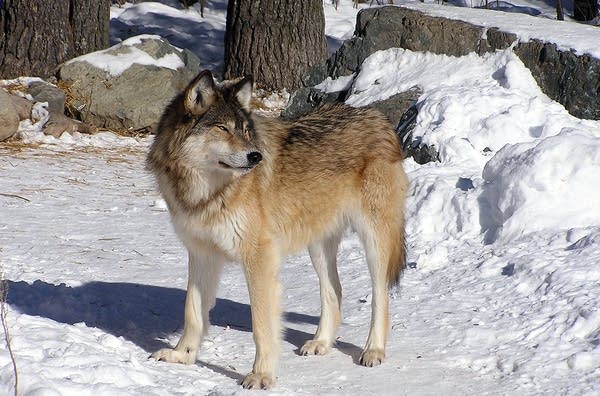Fourth try underway to remove gray wolf protections
Go Deeper.
Create an account or log in to save stories.
Like this?
Thanks for liking this story! We have added it to a list of your favorite stories.

After three failed attempts, the U.S. Fish and Wildlife Service is again considering whether to remove the gray wolf from federal protection in Minnesota, Wisconsin and Michigan.
Spurred by petitions from the Minnesota Department of Natural Resources and others, the federal agency has opened a public comment period and is expected to issue a recommendation in six months.
The Fish and Wildlife Service has concluded a 90-day review of petitions to remove the region's wolves from protection under the federal Endangered Species Act. Lora Ragan, a Minnesota-based biologist for the agency, said the requests made a strong case.
"We think there is substantial information provided to indicate that delisting may be warranted here in the western Great Lakes," Ragan said.
Turn Up Your Support
MPR News helps you turn down the noise and build shared understanding. Turn up your support for this public resource and keep trusted journalism accessible to all.
The service is inviting public comment, while it continues evaluating the status of gray wolves.
About 3,000 wolves in Minnesota have partial protection under the law. Under certain circumstances, wolves can be killed -- but only when they have harmed livestock. Another 700 wolves in Wisconsin and Michigan are fully protected.
The region's wolves have been removed from federal protection three times. Each time, the decision was reversed after legal challenges from environmental and wildlife groups.
"The states are well-equipped to manage wolf populations, and so we're ready to do that."
Wildlife groups argue that Great Lakes wolves cannot be considered a distinct population from wolves elsewhere -- many in places where historic wolf populations have not recovered.
Because of those decisions, Ragan said, the Fish and Wildlife Service has to come up with a plan that considers how to manage wolves nationwide.
"What we're trying to do now is take a comprehensive look at gray wolf conservation under the Endangered Species Act, to look at wolves throughout the lower 48 states and Mexico comprehensively, rather than looking just at the western Great Lakes, just at the northern Rocky Mountains, just at southwestern wolves," she said.
The service aims to come up with a science-based way to make future decisions.
Federal law requires the service to consider scientific and commercial data, but Ragan said a decision will rely heavily on biology.
New information on wolf genetics could work into the agency's decision. Ragan said researchers have discovered what may be two distinct species of wolves in the Great Lakes, which intermingle in the region.
"We would need to talk about the two different species we have here, how they interact, how we consider those to contribute toward recovery," she said. "Also, we need to take a look at how the Endangered Species Act would deal with this."
The Minnesota Department of Natural Resources asked federal officials to remove gray wolves from protection last March. State Wolf Management Specialist Dan Stark said the agency wanted to get the process moving.
"We've by far exceeded the recovery goals for wolves in our region, and I think that should be recognized and we should move on to other things," Stark said. "The states are well-equipped to manage wolf populations, and so we're ready to do that."
But wildlife groups aren't buying it. Michael Robinson of the Center for Biological Diversity said it would be premature to remove the wolves from the list of threatened species, until the Fish and Wildlife Service comes up with a national wolf management plan.
"What it's attempting to do is piecemeal delisting, without ensuring that wolves will be able to reoccupy and be safe in the vast areas throughout the lower 48 states where they are presently in tiny numbers, highly imperiled or not existing at all," Robinson said.
Removing wolves from the list in Minnesota, he said, could hurt chances of repopulating wolves in the Dakotas.
"Doesn't make sense to leave those animals stranded, as populations may indeed be reduced in the Great Lakes following delisting," Robinson said.
The Fish and Wildlife Service's review will end in the spring, when it concludes whether the data warrants removing wolves from federal protection -- and whether the service has the staff and resources to proceed.




